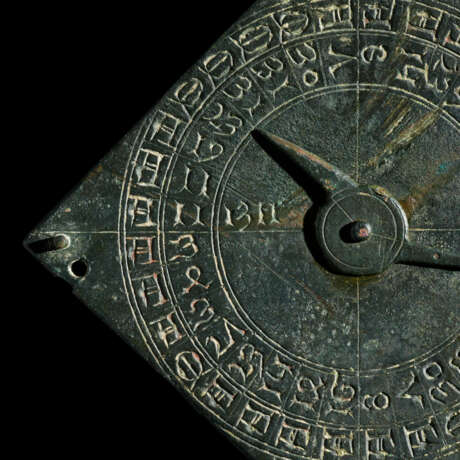ID 1105620
Los 49 | The master of the Chetwode Quadrant
Schätzwert
£ 100 000 – 150 000
An English horary quadrant, circa 1311
The earliest dated English scientific instrument.
The copper-alloy plate engraved to obverse with six unequal hour lines, a shadow square with two scales each numbered 4 8 12, a quadrant arc 0-90 divided to 1 and numbered 15 30 45 60 75 90, the reverse with a revolving index pointer pointer calendrical scales for Easter Sunday, carrying the date 1311. 2 ¼in. (57mm.) radius.
Known by its Latin name quadrans vetustissimus, the science behind its projection for the hour lines can be traced back to a Baghdadi manuscript dating to the 9th or 10th century. Almost certainly introduced to Europe via Islamic Spain, they are first recorded in Montpellier in the late 13th century when the design is modified by the Jewish astronomer Profatius (the quadrans novus). Rather than the system that we use today of equal hours, the projection for telling the time on the quadrans vetustissimus uses unequal hours. This was common in the medieval world when being able to work during daylight was crucial. Unequal hours start at sunrise, midday is 6, and 12 is sunset; thus an hour is longer in the summer than it is in the winter. The instrument's use made it to the upper echelons of society, Queen Isabella received quadrants from St Albans Abbey: "William Orologer, monk of St Alban’s, bringing to the lady queen several quadrants of copper from the like gift by his own hands on the same day: 20s, 6th January [1358]".
The inscription of 1311 predates the previously known earliest inscribed date on an English scientific instrument, the British Museum's 1326 "Chaucer Astrolabe", object reference number 1906,0617.1. It also raises the tantalizing possibility that the Canterbury quadrant, dated by Elly Dekker to 1312 or 1388 based on its lunar volvelle, could be earlier than the currently accepted latter date. Further this newly discovered quadrant bears remarkable similarities to the Chetwode quadrant discovered by detectorist Simon Neal, Christie's South Kensington 15-29 October 2015, lot 1. The composition of the metal, size, and style of engraving suggest they not only come from the same workshop but were made by the same hand - a hitherto unrecorded anonymous maker active in England in the early 14th century.
Literature
Davis, J. 'The Chetwode Quadrant: A Medieval Unequal-Hour Instrument', in Bulletin of the British Sundial Society 27 (2015) pp.2-6.
| Adresse der Versteigerung |
CHRISTIE'S 8 King Street, St. James's SW1Y 6QT London Vereinigtes Königreich | ||||
|---|---|---|---|---|---|
| Vorschau |
| ||||
| Telefon | +44 (0)20 7839 9060 | ||||
| Aufgeld | see on Website | ||||
| Nutzungsbedingungen | Nutzungsbedingungen |










